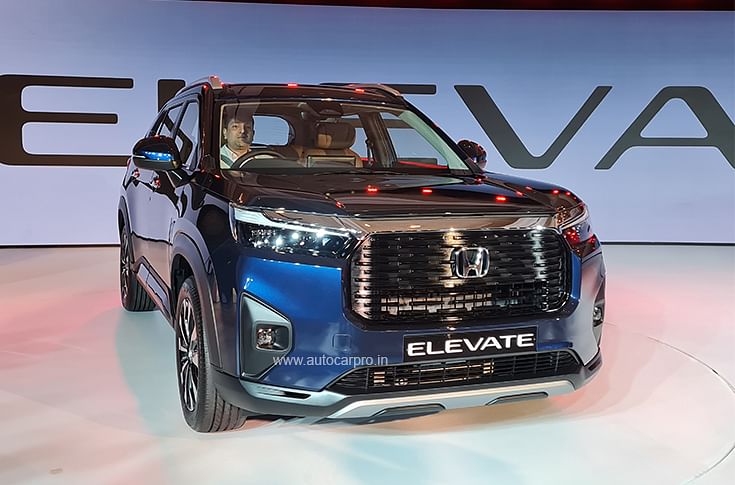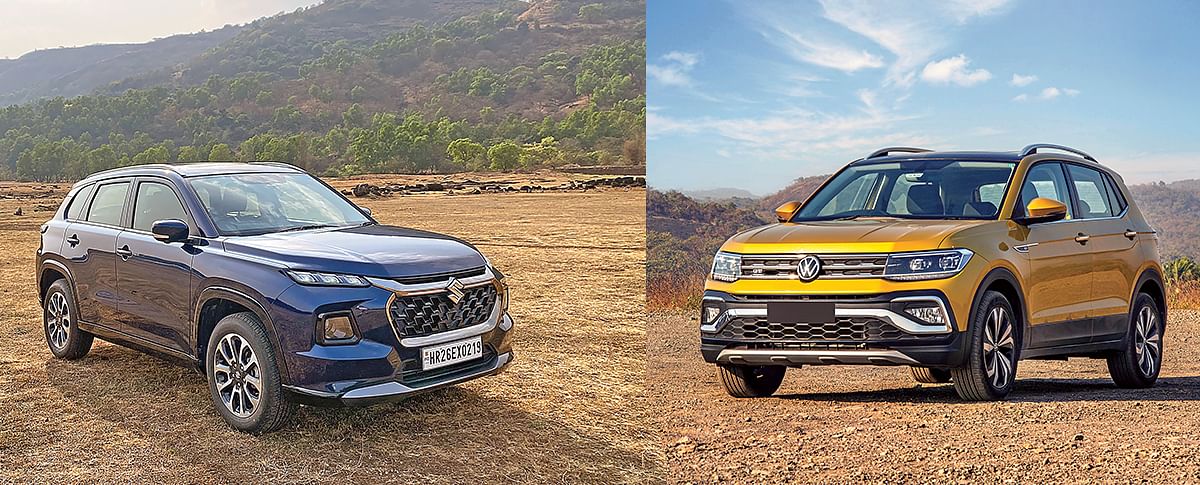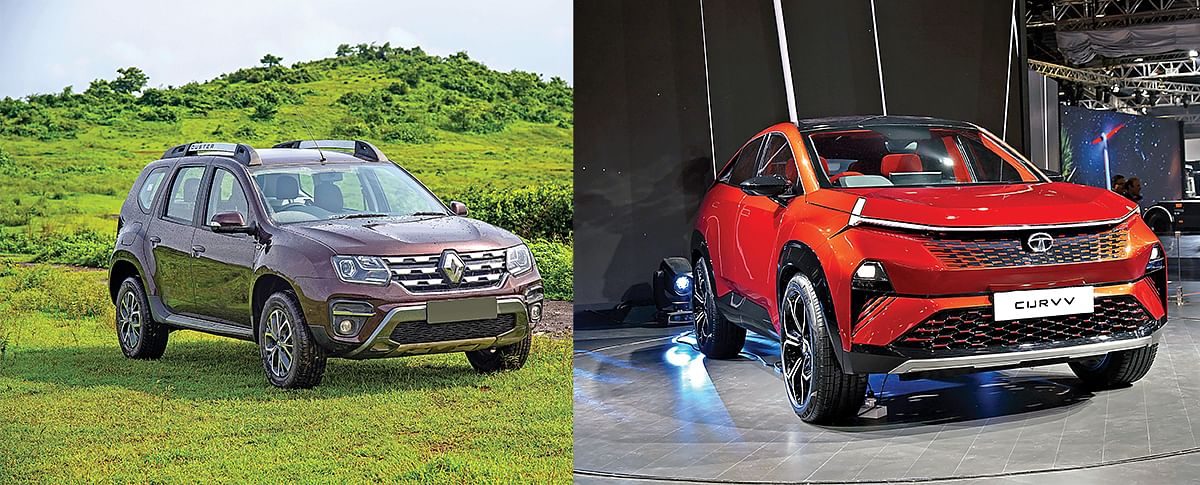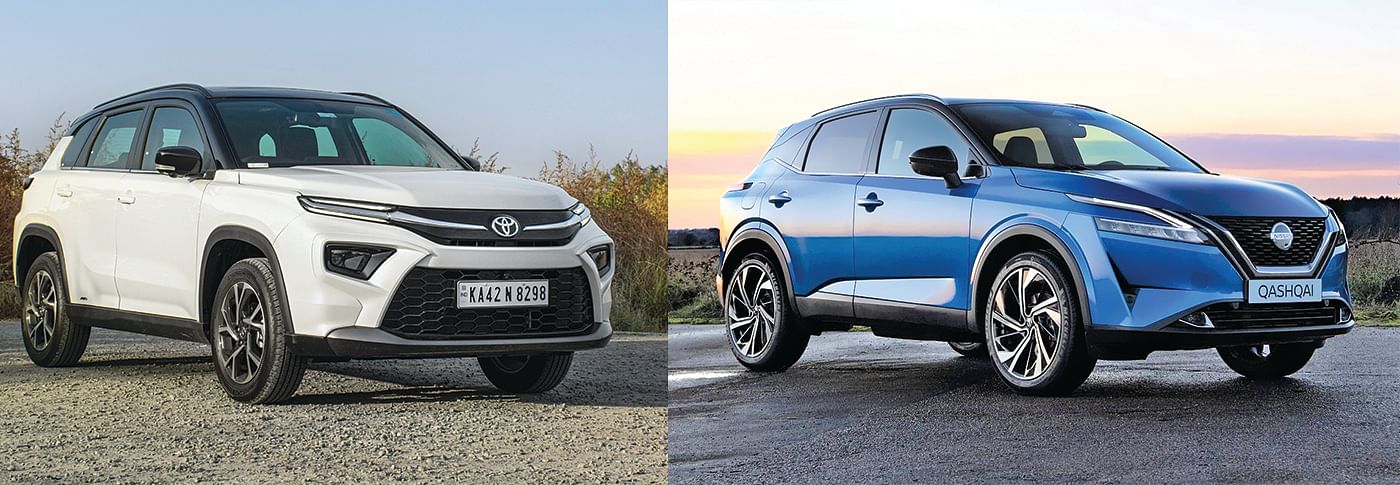Mid-size mania: Indian car market's new battleground
In the past eight years, the mid-size SUV market has grown almost eight times accounting for nearly 22 percent of the PV market, and no auto maker wants to be left behind.
Honda Cars India premiered its much-awaited global SUV Elevate in the national capital this month. The unveil marked yet another alternative from an automaker that wants to regain relevance in the Indian market. This is an indicator of how the wind is blowing towards mid-size SUVs. The launch fills a critical gap in the portfolio of the sedan specialist — and expands the addressable market for Honda to over 30 percent of the market. A gap that had been all the more noticeable because of the fantastic boom that the segment has been witnessing.
The mid-size SUV (4.2-4.3 metres in length) has been conspicuous by its absence from the Honda stable due to the restructuring exercise undertaken by the Japanese company a few years ago. However, Honda has now righted this. Leaner, meaner and profitable, Honda aims to get back into the reckoning in the fast-growing passenger vehicle market in India with not one, but five SUVs by 2030.

The world premiere of the all-new Elevate in India is “a stamp of commitment to Honda's plans and aspirations for India,” said Toshio Kuwahara, President and CEO, Asian Honda Motor and Head of Regional Unit (Asia and Oceania), Honda Motor Company. Kuwahara expects India to remain a key pillar of future growth. “With the successful completion of restructuring thanks to Tsumara San (Takuya Tsumura, the President and CEO of Honda Cars India), we are now in a boosting mode or a growth path. Starting with the new Elevate SUV, we will try to recover everything, volumes, market share and profitability. We are also committing for four other SUVs beyond Elevate by 2030, so stay glued to Honda's progress in India,” assured Kawahara.
Better late than never
The Elevate will be positioned in the fast-growing mid-size SUV market and will challenge the segment leaders Hyundai Creta and Kia Seltos.
The soft roader urban SUV market, which was started by Renault Duster almost a decade ago, took off post the launch of Hyundai Creta in 2015. In the past eight years, the market has grown almost eight times or eight lakh units accounting for almost 20-22 percent of the overall passenger vehicle market.
The mid-size SUV is amongst the fastest growing sub-segment and is all set to be the new battleground in the coming years. Over 100 SUVs are plying on Indian roads and a majority of them are in the Rs 6 lakh to Rs 25 lakh price bracket. Within that broad pie, the mid-size SUVs priced between Rs 12 to Rs 20 lakh are turning out to be the new
sweet spot.
Shailesh Chandra, MD of Tata Motors Passenger Vehicles said the average price points are moving upwards directionally and the emerging sweet spot is Rs 10-15 lakh bracket with the mid-size SUVs.
“The demand wave has moved from high hatchback to CUVs (crossover utility vehicle) in the last five to seven years and it is moving to mid-size SUVs. The segment is going to get stronger with the entry of new players. We will be attacking that space with two differentiated products, the Curvv and Sierra. We expect that, over the next five years, this will be the hot segment of the market before people move to C SUVs five years from now,”
added Chandra.
Spoilt for choice
Just last year, market leader Maruti Suzuki entered the segment with the Grand Vitara along with its sibling Toyota Urban Cruiser Hyryder adding to the choice for prospective buyers. The options are only going to increase.
Apart from Honda Elevate, the French car maker Citroen is set to launch its C3 Aircross later in the year and homegrown car makers Tata Motors and Mahindra & Mahindra will enter the fray in 2024 and 2025. Tata Motors will be launching its Coupe designed Curvv and lifestyle SUV Sierra in 2024 and 2025 respectively. Whereas Mahindra & Mahindra will be launching the elder sibling of theXUV 300 in 2025. Renault will be relaunching the all-new Duster and its alliance partner Nissan too will be launching a mid-size SUV in 2025.
Suffice to say, given the increasing alternatives, both Hyundai and Kia are expected to give their own offerings, Creta and Seltos, a major facelift within the next one year.
Over the past few years, the Indian market has reached new heights fuelled by buyers who are upgrading. While first-time car buyers are critical to increase motorisation, it is the buyers who want to upgrade that will help in sustaining the growth momentum, said Chandra.
New battle ground
Experts say SUVs are more profitable than hatchbacks and sedans, and they bring in more money for the vehicle maker. This is why there has been a feverish focus to get into the segment.
Ravi Bhatia, President of Jato Dynamics India said, “From an affordability standpoint the B segment SUV is the most attractive price point for the growing middle class and it clearly is the new battleground.
“The SUV market too will go through the same evolutionary process one saw with hatchbacks and sedans. With the growing market, new entrants are foraying into the space. Next, the segment will get sub-segmented and the battle will start intensifying. While the pie will keep growing, there will be a fierce battle for market share. But in the end, it boils down to strong brands, an attractive value proposition, a healthy distribution and lower service cost,” added Bhatia.
 Interesting new challengers are beginning to make their mark in the mid-sized SUV segment like the Maruti Grand Vitara and Volkswagen's Taigun.
Interesting new challengers are beginning to make their mark in the mid-sized SUV segment like the Maruti Grand Vitara and Volkswagen's Taigun.
The SUV market will have an additional element of diverse powertrains, i.e electric, hybrid, diesel, turbo petrol, which will cater to specific needs of buyers. Distinct design and a strong road presence will turn out to be a critical factor to woo buyers.
Bhatia said much like the other segments of the market, with time, the SUV market will get sliced and spliced into affordable or entry SUV segments, the value-for-money offering and finally the premium offering and the same can be seen with over 50 alternatives available in the market, right from Rs 6 lakh to Rs 40 lakh.
“One has already seen the entry of the affordable SUV segment getting highly populated, hence the mid-size SUV segment or above four metre segment becomes a very attractive proposition in the market and that is what is being played out right out. The biggest disruptive factor at the moment is that the gorilla of the industry, Maruti Suzuki, has woken up. Maruti will disrupt the space along with Toyota, and will significantly change the market share dynamics,” explained Bhatia.
Maruti Suzuki has already sounded the bugle and has announced that it is eying leadership position in the SUV segment. This is at a time when the homegrown car makers Tata Motors and Mahindra & Mahindra lead the race as Number One and Number Two with just a few hundred units between the two. With the all new Fronx, Grand Vitara and Jimny falling in the sweet spot of the Rs 10 to 20 lakh bracket, the market leader is sure to disrupt the space.
Experts say what makes this segment attractive is that not only is it profitable, but it is also relatively insulated from inflationary challenges or a slowing GDP.A case in point are the last few quarters, even as the GDP has moderated, the mid-SUV market continues to witness a healthy flow of bookings. More than half of the pending bookings — numbering over eight lakh— come from the Rs 10-25 lakh bracket which is where the core of mid-size SUVs market is positioned.
Maturing Indian buyers
Gaurav Vangaal, Associate Director, S&P Global Mobility said that the growth in the segment is a sign of the Indian market maturing on the back of rising disposable incomes, increased product action, higher replacement demand and the addition of second cars, especially for women drivers.
“The B SUV segment output has jumped over 14 times to 1.4 million units in the last decade with a compounded annual growth of 39 percent. We expect this growth to continue on the back of growing incomes to breach two million vehicles by the end of the decade,” said Vangaal.
With the rising base of B SUVs, the compounded annual growth rate will normalise to single digits. However, one expects the upgrading cycle to continue to C- and D- segment SUVs in the coming decade.
Vangaal said the B SUV has become the core of the market and it will create a strong base for buyers to pivot to more premium SUVs by the end of the decade.
“Most multinationals are already present in the segment. As per our understanding, the success of Mahindra XUV 700 has drawn their attention towards the C-Segment and we can expect to see much more action in the C-segment going forward,” Vangaal added.“So far, diesel has played an important role in the segment, however with upcoming stringent emission norms, we expect that the hybrid is going to play a significant role in driving the numbers. Current booking levels/ waiting periods for the strong hybrid indicate the expected increased penetration in the coming years. We also expect high product action in B-Segment EV SUVs too, bringing interesting competition between hybrids and EVs in the mid-term.
Plotting the evolution
This segment, characterised by vehicles with a perfect blend of power, versatility, and practicality, has captivated the imagination of Indian car buyers. The combination of ruggedness, space and potent powertrains has made mid-size SUVs immensely popular, reshaping the Indian automotive landscape.
The transformation of the mid-size SUV segment began around 2012-2015, when a few automakers recognised the untapped potential of this market in India. This realisation led to the introduction of some breakthrough models such as the Renault Duster (2012) — which started it all — followed by the Hyundai Creta (2015), which has evolved into a powerful brand. These early entrants offered an appealing package of comfort, durability and a spacious cabin in a relatively compact footprint compared to full-size SUVs, thereby resonating with a wide range of Indian consumers.
The increasing popularity of mid-size SUVs can be attributed to a significant shift in consumer demand away from sedans fuelled by rising disposable income.
Even though the overall passenger vehicle market is set to slow down to a single digit growth, the SUV segment is still expected to grow by over 10 percent in the current financial year. Approximately 1.9 million SUVs are likely to be sold in FY24 which is an overall contribution of about 45-46 percent, say industry experts.
The shifting buyer preference in the Indian market sought vehicles that were not only practical for urban commuting but also capable of handling rough terrains and providing a commanding driving position. Furthermore, the desire for adventure and exploration, coupled with the need for a spacious vehicle for family outings — a trend which particularly gained pace after Covid-19 — played a crucial role in the rise of mid-size SUVs in India’s passenger vehicle market.
Increased options propelled market expansion
The success of early entrants — Renault Duster and Hyundai Creta — in the mid-size SUV segment prompted more automakers to tap into this lucrative market in India.
As a result, domestic and international manufacturers alike started introducing their offerings, intensifying competition and providing consumers with a wider range of choices.
 First mover models like the Renault Duster will renew its market positioning whille soon-to-arrive models like the Tata Curvv will create its own niche.
First mover models like the Renault Duster will renew its market positioning whille soon-to-arrive models like the Tata Curvv will create its own niche.
The Korean giant Hyundai Group dominates this category of vehicles with two best-selling products under the Hyundai and Kia brands respectively — Hyundai Creta and Kia Seltos. Other OEMs soon followed, including India’s largest carmaker Maruti Suzuki India, along with its alliance partner Toyota, as well as Skoda and Volkswagen. All these companies have now ventured into the segment with their products that aim to cater to the needs of young and aspirational car buyers. Each model comes with a distinctive set of features and competitive pricing.
This surge in options has expanded the market, making mid-size SUVs accessible to a broader range of Indian consumers. As a result, with almost 3.9 million units in FY23 in India, mid-size SUVs contribute around 22 percent of the total passenger vehicle sales today.
According to Shashank Srivastava, Senior Executive Officer, Marketing and Sales, Maruti Suzuki India, “The mid-size SUV segment is now the second-largest sub-segment in India — the largest being the entry-level compact SUVs. While entry-SUVs now comprise about 25 percent of the total PV market, mid-size SUVs have a 22 percent share. Therefore, it is a substantially big market overall.”
“Of the 16,70,000 SUVs sold in India in FY23, 7,59,000 units were that of mid-size SUVs. At MSIL, we started sales of the Grand Vitara SUV in September 2022, and clocked overall sales of 56,400 units in the second half of FY23, to grab a 7.5 percent share of the mid-size SUV market. In the first two months (April and May 2023) of FY24, our mid-size SUV market share has already climbed to about 14 percent, owing to the strong demand for the Grand Vitara,” Srivastava added.
The Grand Vitara’s badge-engineered version — Toyota Urban Cruiser Hyryder— which was also introduced in September 2022 as part of the Suzuki-Toyota global alliance, has, on the other hand, clocked overall sales of 25,455 units in the first seven months of its launch in the country.
 Japanese car makers are late to the party but they will be formidable opponents
Japanese car makers are late to the party but they will be formidable opponents
in the future.
Toyota’s strong-hybrid technology which is one of the key unique selling propositions of these SUV twins, has commanded almost 50 percent share of its total sales, therefore, clearly determining the shift in the consumer mindset towards high-on-efficiency, sustainable motoring solutions.
On the other hand, Hyundai Motor India’s best-selling Creta SUV is the segment king. It was introduced in the country in July 2015, has registered overall sales of 8,76,930 units until April 2023, and is inching closer to its 10-million-units milestone. Hyundai’s sister brand Kia, which forayed into the Indian market in August 2019 with the Seltos SUV, also saw immediate market success with its maiden mid-size SUV product going home to 3,78,229 buyers until April 2023. The Seltos is a shining example of how
a relevant product, introduced in the market at the right time, could spell tremendous success even for a completely new brand in the Indian market.
While the German duo of Skoda and Volkswagen have collectively sold 88,576 units since the launch of the Skoda Kushaq in June 2021 and Volkswagen Taigun in September 2021, respectively, the Japanese giant — Honda has been absent from this space. But the carmaker has recently unveiled its Elevate mid-size SUV, which is slated to go on sale in the market in the festive season of CY23. The company aims for a 35 percent uptick in volumes in the second half of FY24, once the Elevate is introduced into its portfolio.
The affinity of the buyer towards the vehicles of this segment is so strong that no manufacturer would risk not having a product in this space. As a result, even a new market entrant, Citroen, has already showcased its upcoming mid-size SUV, C3 Aircross, which is also slated for introduction in the festive season. The company will position the C3 Aircross as a product offering a unique seven-seat configuration option as well. According to Thierry
Koskas, CEO, Citroen, “We have huge expectations from the C3 Aircross. We believe it will become a main competitor in the busy mid-size SUV segment. We aim to offer a stellar driving experience coupled with roominess
inside the cabin with a 5+2 option — something unique in the segment.”
Powertrain puzzle
The growth of the mid-size SUV segment has been further fuelled by technological advancements in powertrains and drivetrains, as well as by the integration of modern features in these products. While diesel continues to form a chunk of the mid-size SUV sales in the country, the trend is moving towards petrol and hybrids, owing to the ever-tightening emission norms.
The Korean duo Hyundai-Kia continues to rely on the 1.5-litre diesel mill to contribute a major portion of the mid-size SUV sales. Meanwhile the Japanese Suzuki-Toyota duo is betting big on the hybridisation of their 1.5-litre internal-combustion petrol powertrain to offer an equally efficient engine enabling longer tank range, and better utility of these SUVs across urban and highway usage. The introduction of hybrid powertrains has also started addressing the growing concern for environmental sustainability, appealing to a broader customer base.
The segment has also sparked the trend of powerful turbo-petrol engines. Skoda-Volkswagen with the TSI mills, as well as Hyundai-Kia with the GDI engines are luring enthusiasts, by offering them potent engines coupled with fast-shifting dual-clutch transmissions for an engaging drive.
Furthermore, over the last couple of years, automakers have begun equipping these vehicles with advanced safety features such as ADAS, connectivity options, and modern infotainment systems, catering to the tech-savvy Indian consumers. Additionally, features such as a panoramic sunroof which has become a rage among consumers, have become market trends. These trends are now driving future-oriented investments from global Tier I suppliers to be ready for growing demand. While diesel remains a big driver of mid-size SUV sales with over 40 percent market share, automakers have started investing heavily in the research and development to also introduce greener CNG, electric and hybrid powertrains, aligning with sustainability targets and stricter emission norms.
Feature packed and global SUVs
The introduction of cutting-edge technologies such as advanced driver assistance systems (ADAS) safety features and connected car solutions are further set to enhance the driving experience of mid-size SUV customers. Meanwhile advanced connectivity, customisation options and personalised features will cater to the diverse needs and preferences of Indian consumers, ensuring the sustained popularity of mid-size SUVs.
The segment is also creating a trend of not just global products coming into India, but also India-specific models which can cater to the requirements of several markets overseas. For instance, Honda Cars India is all set to explore the potential of exporting the Elevate to markets in the Middle East and South Africa. The mid-size SUV space, therefore, is a tour de force, driving the passenger vehicle segment to new heights of robust volumes, as well as accelerating its advancement into the future with new technological trends.
From early entrants capturing the market's attention to the wide array of choices available today, technological advancements and growing buyer aspirations, multiple factors have contributed to the success of the mid-size SUV segment, which has become a symbol of power, versatility, and adventure for Indian car owners.
This feature was first published in Autocar Professional's June 15, 2023 issue.
RELATED ARTICLES
Auto Giants Explore Hybrid Strategy as EVs Hit Speed Bumps
Slower-than-expected EV adoption, tight CAFE norms and ever-present efficiency demands are giving hybrids a second wind ...
Continental Taps India as Global Hub for R&D and Manufacturing
Continental’s spin-off of its automotive business into AUMOVIO marks a strategic shift, placing India’s engineering and ...
India's EV Story: Promise, Progress, and Challenges
Amid the fanfare of new launches and soaring expectations, mainstream buyers remain hesitant.





 23 Jun 2023
23 Jun 2023
 20232 Views
20232 Views





 Ketan Thakkar
Ketan Thakkar


 Shahkar Abidi
Shahkar Abidi


